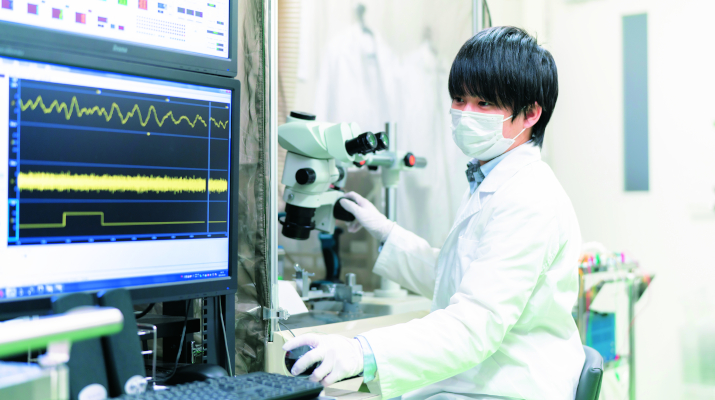

An electrophysiological breakthrough for diabetic brain studies
Delicate brain and gentle electrode Koji Yamashita
A collaborative research team consisting of members from Toyohashi University of Technology’s Institute for Research on Next-generation Semiconductor and Sensing Science (IRES²), Ibaraki National College of Technology, and TechnoPro R&D Company, has successfully demonstrated low-invasive neural recording technology for the brain tissue of diabetic mice. This was achieved using a small needle-electrode with a diameter of 4 µm. Recording neuronal activity within the diabetic brain tissue is particularly challenging due to various complications, including the development of cerebrovascular disease. However, the team proved that damage to the brain tissue can be minimized by the small needle-electrode. Thanks to the superiority of the miniaturized needle-electrode compared to conventional technologies in this respect, the team could achieve stable recording for an entire month.
Diabetes is known to cause various complications, including the development of cerebrovascular disease, which is closely linked to Alzheimer’s disease due to its contribution to neuronal reduction. In the study of brain diseases, quantitative analysis through recording of neuronal activities with microelectrodes holds great potential. However, recording from diabetic brains is expected to be more challenging than normal brains due to the complications associated with electrode penetration. The research team has successfully addressed this challenge by developing a low-invasive recording technology.
The first authors of this study, master’s graduate Rioki Sanda and Koji Yamashita, PhD, outlined their goal as follows: “Our challenge was to develop a technique to record neuronal activities from a mouse model of diabetes. We achieved this goal by demonstrating a neural recording technique using a microelectrode with a tip diameter of 4 µm. Our technique successfully recorded neuronal activity in diabetic mice while minimizing tissue responses. These findings suggest that our electrode can be applied to various damaged brain tissues, not only diabetes but also other diseases.”
Professor Takeshi Kawano, leader of the research team, explains the motivation behind their project: “Diabetes is a complex disease known to cause various complications, particularly vascular disorders. These disorders can lead to gangrene in the limbs, ultimately necessitating amputation. Brain-machine interface (BMI) technology holds immense promise in assisting patients who have lost limbs, enabling them to control artificial limbs through brain signals. However, the penetration of conventional electrodes into diabetic brain tissues induces damage, making the application of BMI technology in these patients considerably riskier than others. Recognizing this crucial need, we launched a project to develop a low-invasive recording technique specifically for patients suffering from diabetes-related vascular disorders.”
The research team is confident that their recording technology, demonstrated successfully in diabetic mice, holds significant potential for broader applications. They envision its use in drug discovery studies using diverse model mice with various diseases. Furthermore, the team aims to expand the technology’s reach to other animal models, including rats and monkeys, to accelerate the development of next-generation BMIs with greater efficacy and wider applicability.
This work was supported by JSPS KAKENHI (Grant Numbers 17H03250, 26709024, and 20H00244) and Strategic Advancement of Multi-Purpose Ultra-Human Robot and Artificial Intelligence Technologies program from NEDO, Adaptable and Seamless Technology transfer Program through Target-driven R&D (A-STEP) from JST, and Nagai Foundation for Science & Technology. R. N. was supported by the Takeda Science Foundation. K. K. was supported by JSPS KAKENHI (Grant Number 15H05917, 20H00614).

Reference
Rioki Sanda, Koji Yamashita, Hirohito Sawahata, Kensei Sakamoto, Shota Yamagiwa, Shohei Yokoyama, Rika Numano, Kowa Koida and Takeshi Kawano (2023). Low-invasive neural recording in mouse models with diabetes via an ultrasmall needle-electrode, Biosensors and Bioelectronics, https://doi.org/10.1016/j.bios.2023.115605.
糖尿病のための脳計測技術
よわい脳とやさしい電極 山下 幸司豊橋技術科学大学次世代半導体・センサ科学研究所 山下 幸司研究員、三田 理央毅さん(2021年3月 本学電気・電子情報工学専攻修了)、河野 剛士教授、沼野 利佳教授、鯉田 孝和准教授と茨城工業高等専門学校、テクノプロR&Dの研究チームは、直径が僅か4 µmの刺入型プローブを用いて、糖尿病モデルマウス脳組織からの低損傷での計測に成功しました。糖尿病マウスの脳組織は、脳血管障害の発症などにより脳組織からの直接的な電気信号の取得が困難ですが、世界最小級のプローブを用いることで血管への損傷や脳組織の免疫作用を最小限に抑えられることを証明しました。
糖尿病は、脳血管障害の発症を含めて様々な合併症を引き起こすことが知られています。さらに、血管障害は神経細胞の減少につながり、アルツハイマー病とも密接に関わっているとされています。脳疾患に関する研究分野では、動物モデルの行動解析だけでなく、刺入型電極による電気的記録を用いた定量評価が期待されています。しかし、刺入型電極は脳組織に対して直接刺入を行うため、血管や脳細胞に損傷を与えるだけでなく、神経細胞ネットワークの破壊を引き起こすことで、自然な脳からの信号取得ができないという課題がありました。加えて、糖尿病などの繊細な脳からの信号取得は、従来の電極では脳に対する損傷のリスクが高まります。
これらの課題に対し、本研究チームは、世界最小級である4 µm直径の刺入型プローブを用いることで、脳に与える損傷を極限まで低減可能な計測技術を開発しました。
「今回私たちは、糖尿病モデルマウスという、最も小さく繊細な大脳皮質をもつ動物からの神経信号取得に取り組みました。本研究で用いた電極の直径は4 µmと、従来より小さい電極となります。この微細な形状により、電極が血管に与える損傷や脳への埋め込み時に生じる免疫反応を有意に抑えられることが実験結果より明らかとなりました。これらの結果は、糖尿病などの繊細な脳組織に私たちの電極が応用できることを示唆しています。」と筆頭著者の山下 幸司研究員と三田 理央毅さんは説明します。
研究チームリーダーの河野 剛士教授は、「糖尿病は様々な合併症を引き起こす病気であり、特に血管障害は手足の壊疽(えそ)を誘発し、最終的には四肢の切断という決断を余儀なくされます。近年、急速に発展をしているブレイン・マシン・インターフェース(BMI)技術は、義手・義足の方々に希望を与える技術の1つと言えます。しかしながら、BMIに使用される神経電極は脳に与える損傷が大きいため、糖尿病により血管障害を発症している患者の方々にとっては適用のリスクが高くなり、BMI技術の導入が困難であることが予測されました。そこで、糖尿病などにより血管障害を発症した脳に対するやさしい計測を行うためのプロジェクトを立ち上げました。」と語っています。
研究チームは、今回開発した糖尿病モデルマウスのための計測技術は、糖尿病だけでなく繊細な脳組織をもつ他のモデルマウスを用いた創薬研究などにも応用可能と考えています。また、ラットやサルなどの他の動物種への応用も可能であると考えており、次世代型のブレイン・マシン・インターフェースへの展開も可能と考えています。
本研究は、JSPS科学研究費(基盤研究(B)17H03250、若手研究(A)26709024、基盤研究(A)20H00244、20H00614、新学術領域研究(研究領域提案型)15H05917)、NEDO(次世代人工知能・ロボット中核技術開発)、科学技術振興機構A-STEP(トライアウト)、公益財団法人 永井科学技術財団、及び公益財団法人 武田科学振興財団の助成を受けたものです。
Researcher Profile

| Name | Koji Yamashita |
|---|---|
| Affiliation | Institute for Research on Next-generation Semiconductor and Sensing Science (IRES²) |
| Title | Project Assistant Professor |
| Fields of Research | Micro/Nano Devices, Neural Interface Devices |
| Graduated KOSEN | National Institute of Technology, Kagawa College |
